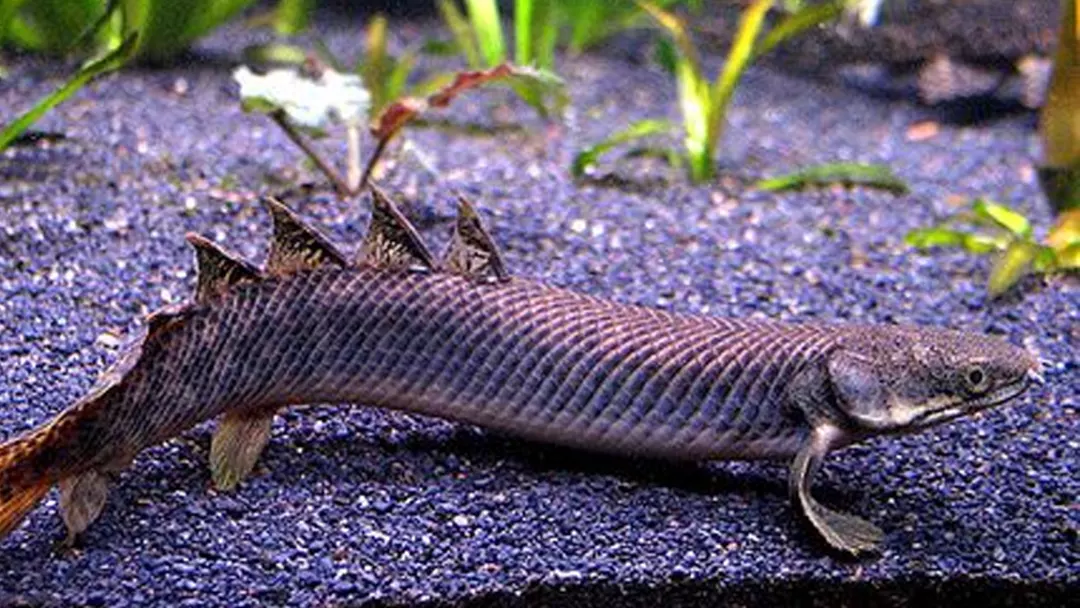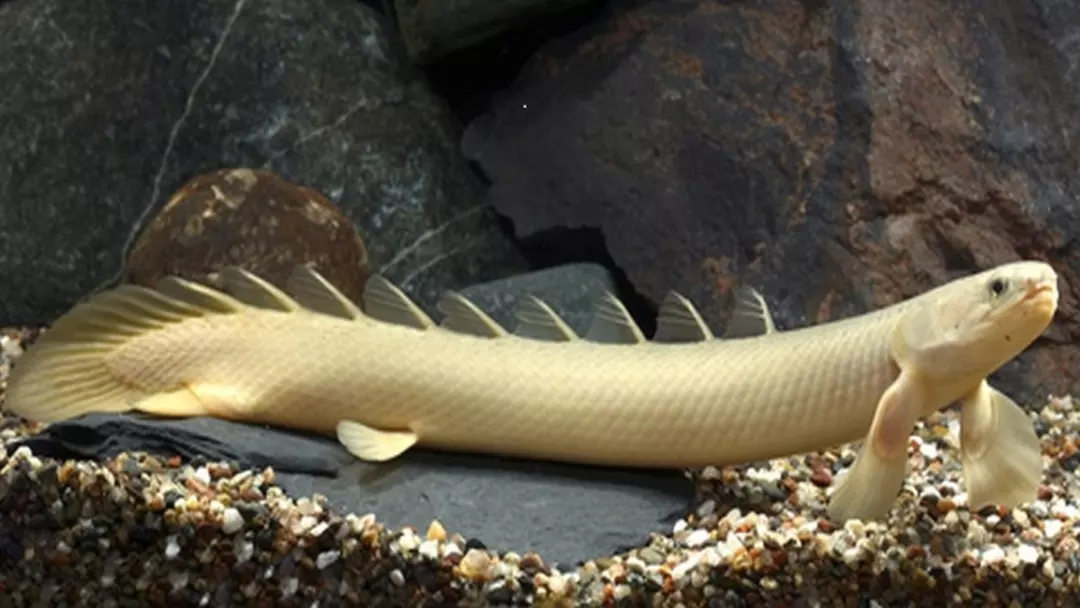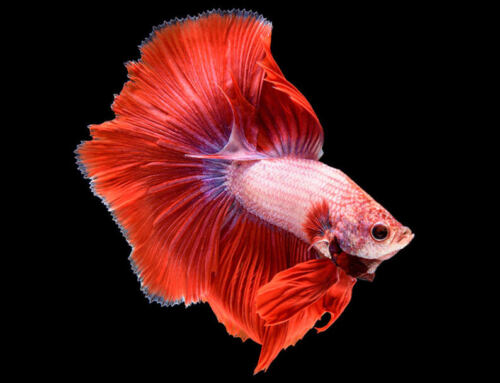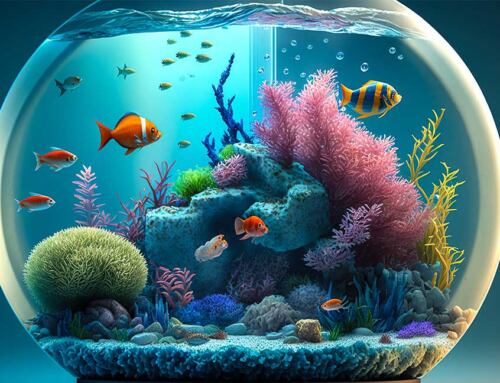Bichirs, or Polypterus bichir, are a species of extremely ancient tropical freshwater fish. Their distribution spans the Nile and its tributaries in Northeastern Africa, where they form the family Polypteridae.
Bichirs thrive in brackish or slightly salty water, but they prefer the warmer, shallower waters of swamps. They are physically suited to this environment, which may explain why they have persisted unchanged for so long. These fish have terrible eyesight because they evolved in murky waters. Good eyesight is useless because there isn’t enough light to see anything.
Bichirs rely on their other senses, such as smell and hearing, to get around and find food. Not only do they have an acute sense of smell, but they can also detect electrical currents in the water. Ampullae of Lorenzini are tiny organs that allow these creatures to sense the electrical fields of other marine organisms. This is, as you might expect, incredibly helpful.
Bichirs are a fascinating species of full-grown dinosaur bichir to study because they have lungs and must swim to the surface for air. The waters where they originate are typically so murky and polluted that it is difficult to breathe. The structure addresses those concerns.
The lungs of the bichir are a little bit different from the lungs of other fish, like the dwarf gourami. A bichir’s lungs are more of a sac than a solid mass of tissue. Neither appears to offer any significant benefits over the other; rather, this is simply how they evolved over time.
The sexing of these fish is similarly challenging. This creates a great deal of unpredictability when shopping for them, but unless your intention is to breed them, it shouldn’t be too much of an issue.
How to Care for Dinosaur Bichir

Care for a dinosaur bichir full grown is not overly challenging, but there are a few things you should be aware of before getting started. The good news is that these fish have a high tolerance for stress. Any aquarist with some level of experience should be able to successfully maintain the water parameters within a reasonably broad range.
On the other hand, there are aspects of behavior and diet to take into consideration, both of which add a little bit more work to the process. We believe that, all things considered, the level of difficulty associated with caring for dinosaur bichir full grown is about average. If you really want one, and you stick to our recommendations below, you should be able to manage it!
What is the Diet of Dinosaur Bichir

Since bichirs are meat eaters, you’ll need to make sure they get enough protein-rich food to stay healthy. They also eat at night, which is another thing that sets them apart from many common freshwater full-grown dinosaur bichir.
Because dinosaur fish bichir sleeps during the day, you’ll need to feed them at the right time. It’s best to go at night or early in the morning before their lights are on. It’s hard to get a fish to stop doing what comes naturally, which is to eat. Work with them instead of against them!
When it comes to what dinosaur fish bichir eat, bichirs are a little harder to care for than other fish. You shouldn’t just give dinosaur fish bichir pellets or flakes. Instead, you should give them a mix of live, dry, and frozen foods that are high in protein. This will make their lives more interesting and bring out their natural instincts to hunt, which is a lot of fun to watch.
What is the Behavior of Dinosaur Fish Bichir

When caring for a bichir, their temperament is one of the most important things to know. Even though they aren’t very aggressive, they do have aggressive tendencies that you need to deal with.
When you add the fact that they eat meat to this, it can cause trouble with the other fish in their tank. Your bichir could go after anything about their size or smaller (we cover tank mate details in the following section).
Aside from their personalities, they are pretty active most of the time. These fish live on the bottom, but they come to the surface often to breathe. Because of this, they move around a lot, which makes them fun pets to have.
How to Breed Full Grown Dinosaur Bichir

There is a lack of resources for those hoping to learn how to breed bichirs. In general, the process has not been carried out in many home aquariums, so the amount of information we have is restricted.
Not much is known about the specific tank and water requirements for breeding each species of bichir. What this means is that you may need to conduct some experiments if you’re serious about this area of study.
The Senegal bichir is the most commonly discussed species when it comes to breeding. It appears that cooler water has a positive effect on the reproductive success of these bichirs. It’s recommended that you use a mixture of soft, slightly acidic water. To complement this, you should up your pet’s protein consumption.
A male will chase after a female and headbutt her gently. This courtship phase may last for two days. If she is successful, she will begin looking for a place to lay her eggs. When the eggs have been fertilized, you can take the parents out of the tank and start feeding the fry. Foods like brine shrimp and micro works, which are easy to find, are good choices for growth.
What is the Possible Illness in Dinosaur Eels?

Illnesses that are only found in bichirs are not something you need to worry about. Instead, you should watch out for the usual suspects like Ich.
However, if you give your fish a lot of TLCS and make sure their tank and water are always clean, you can greatly lessen the likelihood that they’ll get sick. Treatment of an illness or infection is difficult and often unsuccessful, so preventing it is always the better option.
Maintain a regular schedule of water changes and keep close tabs on your fish to catch any signs of illness early. A good owner is someone who can respond quickly and effectively to any unusual situation.
Conclusion
Having a bichir as a pet is an amazing experience. These dinosaur eel are fascinating to observe, and their resemblance to prehistoric ancestors will leave you in awe. In addition, they are more active than many other bottom-feeding fish, making them a welcome change of pace. They frequently come up to the surface, at least, to breathe fresh air.
Care for bichirs is similarly uncomplicated. Just make sure they’re in an appropriate environment, the water’s being checked regularly, and they’re not sharing a tank with the wrong species. One of our favorite freshwater fishes because of how neat they look and how easy they are to care for. For a long time now, we have been recommending them, and that won’t change.




